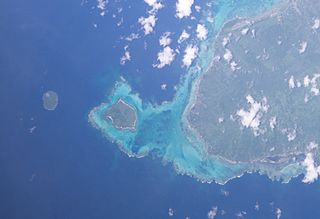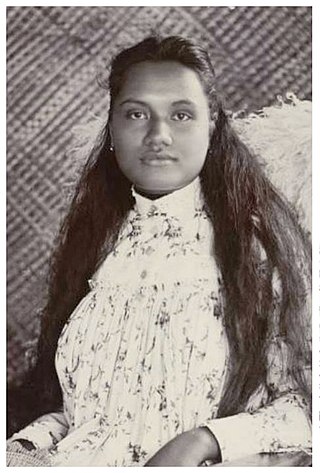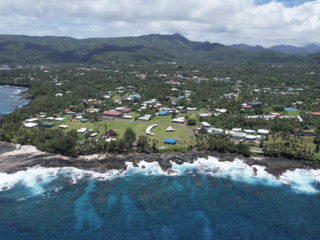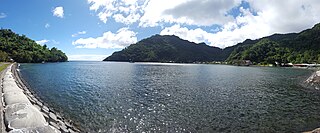
Politics of Samoa takes place in a framework of a parliamentary representative democratic state whereby the Prime Minister of Samoa is the head of government. Existing alongside the country's Western-styled political system is the fa'amatai chiefly system of socio-political governance and organisation, central to understanding Samoa's political system.

John Williams was an English missionary, active in the South Pacific.

Manono is an island of Samoa, situated in the Apolima Strait between the main islands of Savai'i and Upolu, 3.4 km west-northwest off Lefatu Cape, the westernmost point of Upolu. By population just like by area it’s Samoa’s third largest island.

The London Missionary Society was an interdenominational evangelical missionary society formed in England in 1795 at the instigation of Welsh Congregationalist minister Edward Williams. It was largely Reformed in outlook, with Congregational missions in Oceania, Africa, and the Americas, although there were also Presbyterians, Methodists, Baptists, and various other Protestants involved. It now forms part of the Council for World Mission.
The Council for World Mission (CWM) is a worldwide community of mainly Protestant Christian churches. The organisation works to spread the knowledge of Christ throughout the world and to strengthen their 32 members in their mission work by sharing their resources of money, people, skills and insights.

Gagaʻemauga is a district on the island of Savaiʻi in Samoa. The district is situated on the central north side of Savaiʻi. The name 'Gagaʻemauga' literally means "near side of the mountain", meaning the eastern side of the mountain chain running through the centre of Savaiʻi Island.
Protestants in Tuvalu- Tuvalu is one of the most heavily Protestant nations in the world. In 2019, over 92% of the population belonged to a Protestant denomination.
The Congregational Christian Church of Tuvalu, commonly the Church of Tuvalu, is a Christian Church which is the state church of Tuvalu, although this status merely entitles it to "the privilege of performing special services on major national events"; its adherents comprise about 86% of the 11,600 inhabitants of the archipelago.
Vaiee is a small village on the Samoan island of Upolu. It is located on the central south coast of the island. The village has a population of 565.
Faleasi'u is one of the largest village settlements on the island of Upolu in Samoa. It is located on the northwestern coast of the island and has a population of 4177.

Malua is a small village on the Samoan island of Upolu. The name originates from the Samoan word "Maluapapa" which is translated 'shelter under the rock'. It is located on the northwestern coast of the island in the electoral constituency of Sagaga Le Falefa which forms part of the larger political district Tuamasaga.

Aaron Buzacott the elder was a British missionary, Congregationalist colleague of John Williams, author of ethnographic works and co-translator of the Bible into Cook Islands Māori. Buzacott was a central figure in the South Seas missionary work of the London Missionary Society, and lived on Rarotonga from 1828 to 1857. During his time there, he assisted in the development of the written form of Cook Islands Māori, compiling a primer on English and Cook Islands Maori grammar. Buzacott, along with Williams and other missionary colleagues, contributed to the first translation of the Bible into that language, and translated additional theological texts including lectures from his education in London.

Teo Tuvale was a notable Samoan historian who served terms as Chief Justice and Secretary to Government in Samoa during the era of colonialism.

Piula Theological College is a Methodist training institution in Samoa. It was established in 1868 in Lufilufi on the north coast of Upolu island after its initial beginnings in 1859 at Satupa'itea on the south coast of Savai'i island. The Methodist Mission in Samoa purchased the land at the Methodist leaning district and later named their training center Piula Theological College. The name Piula is a transliteration of the biblical name Beulah which means married.

Tui Manu'a Matelita, born Margaret Young, and also known as Makelita, Matelika or Lika was the Tui Manu'a of Manu'a, a group of islands in the eastern part of the Samoan Islands, from 1891 to 1895. During her tenure, she served largely a ceremonial role at her residence on Ta'ū where she received British writer Robert Louis Stevenson. Matelita never married because she would not marry any of the eligible native chieftains and no other men were regarded as having the proper rank to marry her. She died of illness in 1895, although later reports claimed she died by a more violent means. She was buried in the Tui Manu'a Graves Monument.
The Congregational Christian Church of American Samoa (CCCAS) or the "Ekalesia Faapotopotoga Kerisiano i Amerika Samoa" (EFKAS) is a theologically Calvinist and congregational denomination in American Samoa.

James Sibree (1836–1929) was an English missionary in Madagascar with an interest in the natural history and cultural history of the island. He was a contemporary of the French naturalist Alfred Grandidier and wrote detailed books about the flora and fauna of Madagascar, the country's general history, and the mission history on the island. He also helped revise the Malagasy Bible and wrote several works in the Malagasy language. He was a vocal advocate of Malagasy independence prior to the French invasion of Madagascar in 1895. Sibree also designed and helped build almost 100 new mission buildings and 50 churches in Madagascar. He was a fellow of the Royal Geographical Society and earned an honorary degree from the University of St Andrews. Swiss zoologist Charles Immanuel Forsyth Major named Sibree's dwarf lemur after him in 1896.

Vailoatai is a village in southwestern Tutuila, the main island of American Samoa. It is located on the eastern end of Leone Bay. The village is known for its beautiful malae, nested along the island's rugged southern coast and lined by the fale tali mālō of its village chiefs.
Elekana was the first person to introduce Christianity to the Pacific islanders in what is now called Tuvalu. He was born in the Cook Islands in the 19th century, although the dates of his birth and death are unknown.

Fagasā is a village in the Eastern District of Tutuila Island in American Samoa. The village lies by Fagasa Bay, on the north shore of the island. Its name is Samoan and translates to "Forbidden Bay." The village borders the Tutuila-section of National Park of American Samoa. The trailhead to Mount ʻAlava is located near the village by Fagasa Pass.














